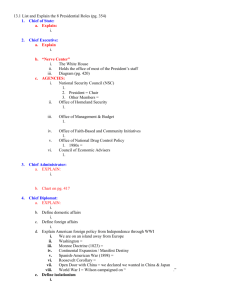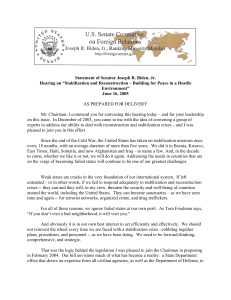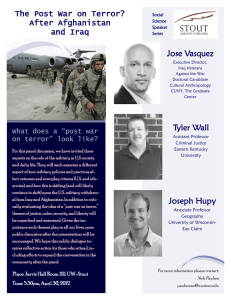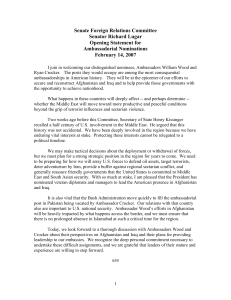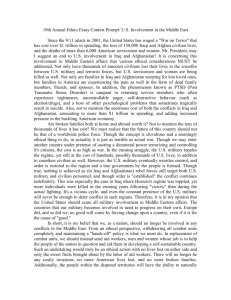The New Imperialism: Stabilization and Reconstruction or the Responsibility
advertisement
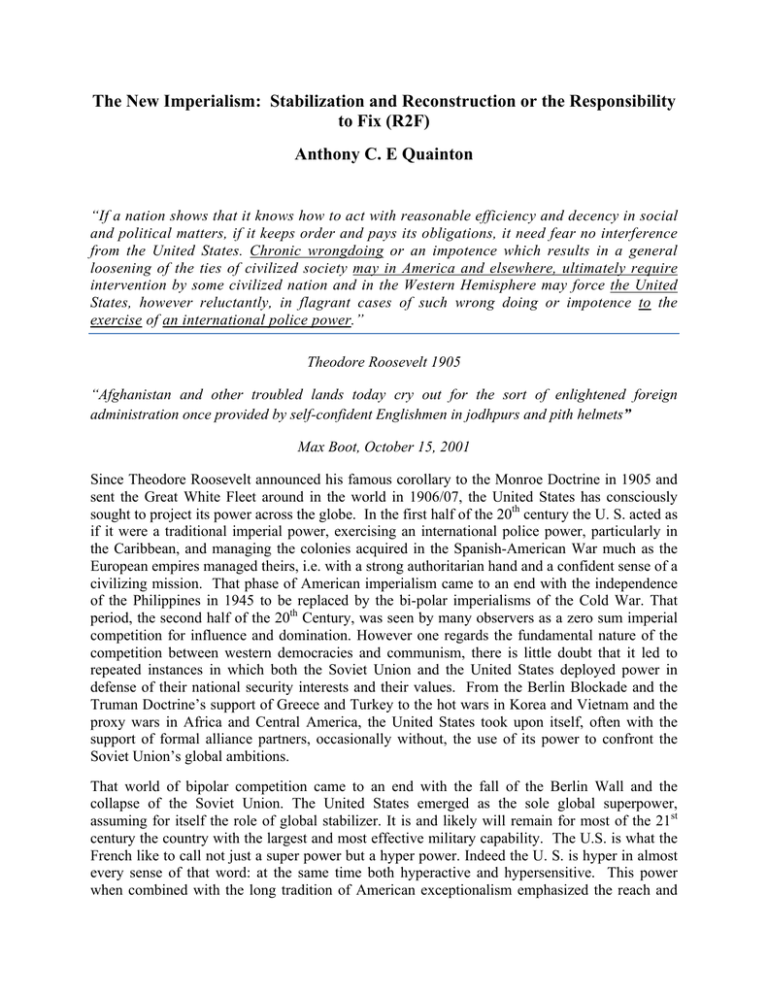
The New Imperialism: Stabilization and Reconstruction or the Responsibility to Fix (R2F) Anthony C. E Quainton “If a nation shows that it knows how to act with reasonable efficiency and decency in social and political matters, if it keeps order and pays its obligations, it need fear no interference from the United States. Chronic wrongdoing or an impotence which results in a general loosening of the ties of civilized society may in America and elsewhere, ultimately require intervention by some civilized nation and in the Western Hemisphere may force the United States, however reluctantly, in flagrant cases of such wrong doing or impotence to the exercise of an international police power.” Theodore Roosevelt 1905 “Afghanistan and other troubled lands today cry out for the sort of enlightened foreign administration once provided by self-confident Englishmen in jodhpurs and pith helmets” Max Boot, October 15, 2001 Since Theodore Roosevelt announced his famous corollary to the Monroe Doctrine in 1905 and sent the Great White Fleet around in the world in 1906/07, the United States has consciously sought to project its power across the globe. In the first half of the 20th century the U. S. acted as if it were a traditional imperial power, exercising an international police power, particularly in the Caribbean, and managing the colonies acquired in the Spanish-American War much as the European empires managed theirs, i.e. with a strong authoritarian hand and a confident sense of a civilizing mission. That phase of American imperialism came to an end with the independence of the Philippines in 1945 to be replaced by the bi-polar imperialisms of the Cold War. That period, the second half of the 20th Century, was seen by many observers as a zero sum imperial competition for influence and domination. However one regards the fundamental nature of the competition between western democracies and communism, there is little doubt that it led to repeated instances in which both the Soviet Union and the United States deployed power in defense of their national security interests and their values. From the Berlin Blockade and the Truman Doctrine’s support of Greece and Turkey to the hot wars in Korea and Vietnam and the proxy wars in Africa and Central America, the United States took upon itself, often with the support of formal alliance partners, occasionally without, the use of its power to confront the Soviet Union’s global ambitions. That world of bipolar competition came to an end with the fall of the Berlin Wall and the collapse of the Soviet Union. The United States emerged as the sole global superpower, assuming for itself the role of global stabilizer. It is and likely will remain for most of the 21st century the country with the largest and most effective military capability. The U.S. is what the French like to call not just a super power but a hyper power. Indeed the U. S. is hyper in almost every sense of that word: at the same time both hyperactive and hypersensitive. This power when combined with the long tradition of American exceptionalism emphasized the reach and importance of American power. As Secretary of Defense Robert Gates said in a graduation address at Notre Dame University this May: “Make no mistake, the ultimate guarantee against the success of aggressors, dictators, and terrorists in the 21st century, as in the 20th, is hard power -- the size, strength, and global reach of the United States military,” Madeleine Albright as early as 1998 was describing America as the “indispensible” power on the world stage. “We are the indispensable nation. We stand tall and we see further than other countries into the future, and we see the danger here to all of us”. The Hart-Rudman Commission in its final report issued only eight months before the tragedy of September 11 assumed that America “must be prepared to act unilaterally if necessary” since he United States is “the prime keeper of the international security commons.” One could, of course, go back almost a hundred years to Woodrow Wilson’s passionate plea to make the world safe for democracy. The United States sees itself as fundamentally different from the rest of the world and with a moral obligation, an almost missionary obligation, to transform the world through the power of its ideas and values, the ingenuity of its diplomats and development experts and, when necessary, through the force of arms. Indispensability is a heavy burden to bear for it implies and requires action on the part of the indispensable power. Technologically there is no military which can compare with the sophisticated systems which the United States can deploy. Its budgetary allocations dwarf those of other countries accounting for almost half (48%) of global spending on defense. The U.S. spends 4.7 percent of its GDP on defense whereas Britain spends on 2.7%, France 2.5% and Germany a mere 1.4%. Its leaders of both political parties have committed the United States to maintaining an ability to project its power to every corner of the globe and to be able to fight two conflicts simultaneously if need be. If the United States has the means to continue to project its power and a long tradition of seeking to do so, what does that imply for the remainder of the 21dt Century? American presidents since the end of the Cold War have been searching for a framework for the projection of American power. The early Clinton Administrations tried to use “enlargement” as a core concept, but it quickly became clear that the U.S. was not sure what it was enlarging: the zone of freedom or something else? Clinton subsequently enunciated what came to be known as the Clinton Doctrine: a doctrine used to justify intervention in Bosnia but which is applicable virtually anywhere in the world to justify intervention for humanitarian reasons. As Clinton put it: “It's easy ... to say that we really have no interests in who lives in this or that valley in Bosnia or who owns a strip of brushland in the Horn of Africa or some piece of parched earth by the Jordan River. But the true measure of our interests lies not in how small or distant these places are, or in whether we have trouble pronouncing their names. The question we must ask is, what are the consequences to our security of letting conflicts fester and spread. We cannot, indeed, we should not, do everything or be everywhere. But where our values and our interests are at stake, and where we can make a difference, we must be prepared to do so”. This concept has been further elaborated by the United Nations in the R2P concept: the Responsibility to Protect. The United Nations has declared that: 1. A State has a responsibility to protect its population from genocide, war crimes, crimes against humanity and ethnic cleansing (mass atrocities). 2. If the State is unable to protect its population on its own, the international community has a responsibility to assist the state by building its capacity. This can mean building earlywarning capabilities, mediating conflicts between political parties, strengthening the security sector, mobilizing standby forces, and many other actions. 3. If a State is manifestly failing to protect its citizens from mass atrocities and peaceful measures are not working, the international community has the responsibility to intervene at first diplomatically, then more coercively, and as a last resort, with military force. However, the problem with this doctrine, which has been embraced by the Obama Administration, is that, while in theory it represents an universal obligation, only the United States has the will and resources to enforce it, particularly if the use of military force required. Libya is a rather poignant example of the difficulty of actually living up to the responsibility to protect. The concept of “leading from behind” which the current Administration articulate, was greeted with scorn in many quarters as an abandonment of the necessary lead role of America. In the period after the terrorist attacks of September 11, 2001, whose tenth anniversary will arrive in only a few days, the United States, exercising its right of self-defense, launched a war in Afghanistan to oust the Taliban and eliminate a sanctuary tor Al Qaida and the perpetrators of the 9/11 attacks. It subsequently engaged in what has come to be called a “war of choice”, to overthrow Saddam Hussein and to eliminate a regime that was erroneously thought to be a key supporter of terrorism and a proliferator of weapons of mass destruction. Without going into the specific justifications for these two wars, about which there remains considerable controversy on both sides of the Atlantic, it is important to look at some of the consequences of those interventions: the principal one being what could be described as the R2F doctrine: the responsibility to fix. Colin Powell famously pointed out that having broken the crockery we had an obligation to fix it. The need to fix Iraq and Afghanistan has resulted in the elaboration of a new doctrine of reconstruction and stabilization operations. In both countries where the United States intervened after 9/11 it was quickly apparent that the “fixing” of these societies was not merely a matter of reforming the security services and empowering the central government, important as both of these two efforts have turned out to be. Looked at from the perspective of the American desire to simultaneously promote both democracy and development, it was evident that nationwide grassroots efforts would be needed to supplement the central government’s efforts. Civil society would also have to be encouraged and supported. The United States, in short, became committed to nation-building. The operational mechanism that evolved is the Provincial Reconstruction Team (PRT) composed of defense, development and diplomatic officers. PRTs are civil-military units originally designed to assist Iraqi provincial governments with developing a “transparent and sustained capability” to govern, promote political and economic development, and provide provincial administration necessary to meet the basic needs of the population. This would appear to be, a classic colonial mission. While the PRT concept was originally designed for Iraq it has been replicated in Afghanistan on a multinational basis. It is ironic that this quintessentially American idea should have been adopted by NATO nations as part of their alliance obligations. Canada, Germany, Italy, Lithuania and the UK all now operate PRTs in Afghanistan, although the United States leads a total of 12 in Afghanistan and 22 in Iraq. It is interesting that different countries use different models. The dominant US model is that each PRT is composed of 80 personnel of which only 3-5 are civilians. They are led by a military commander and have an emphasis on quick impact projects. The UK model averages 100 personnel of which 30 are civilian and emphasizes local capacity building. The German model has 400 personnel of which 20 are civilians focusing on long-term sustainable development. Clearly not all NATO members are singing from the same sheet of music when it comes to nation-building. All are participating in what to many Afghans and Iraqis is a multilateral imperial endeavor. This is not the place to assess the viability of the PRT concept. Suffice it to note that the structures create numerous problems of coordination between foreign ministries, aid agencies and military establishments. Funding availability varies greatly. In the case of the United States, the military has the most available resources for these nation-building tasks: school and health post construction, well-drilling, even the construction of internet cafes. Since 2004 the United States Congress has appropriated $7.6 billion for the Commander’s Emergency Response Program CERP), the basic pot of money available to military commanders for these developmental projects. For Fiscal year 2011 alone the Administration requested $1.3 billion for CERP. These are enormous sums essentially for use in only two countries. The amounts far exceed the resources available to either the State Department or the Agency for International Development for use in the same places. In order to support these new initiatives the White House directed the State Department to create an Office for Reconstruction and Stabilization (matched in the U.K. by a post Conflict Reconstruction Unit). This office, under the immediate direction of the Secretary of State, but in fact located away from the central State Department building, was designed to begin the process of forward planning for future stabilization and reconstruction efforts relying on an interagency mixture of career civilian and military officers supported by a reserve corps of retired civilian officers. As a part of the recently completed Quadrennial Development and Diplomacy Review (the QDDR) this office, which originally was an appendage to the office of the Secretary of State, is to become an independent Bureau of Stabilization Operations with its own Assistant Secretary of State. While the original intention was to give this new office substantial human and financial resources to engage in planning for and implementation of stabilization operations, the current tight budget reality in Washington may not make that possible. What is more significant is the underlying assumption behind first the creation of the PRTs and now a Bureau of Stabilization Operations,. That assumption is that the United States will be called on increasingly in the 21st century to carry out such operations. While the wars on the scale of those in Iraq and Afghanistan may not be repeated, planners in both the State Department and the Pentagon are looking ahead and assume that the United States will be called upon to “fix” increasing numbers of failed, failing or war and disaster-ravaged states. Reportedly the State Department has already identified twenty countries that will be in need of such operations in the next decade. Stabilization and Reconstruction are, of course, different concepts. On one hand stabilization implies an ability of the international community and particularly of the United States to move in to halt the decline of a country by rebuilding its infrastructure, developing civil society and contributing to sustainable development. Failing states will not, under this doctrine, be allowed to fail. Reconstruction is likely to come in two forms: the rebuilding of an economy after conflict and the reconstruction necessary after a major natural disaster (Haiti, Pakistan, Indonesia etc). In both cases it is assumed that the United States will move in with a variety of resources to fix whatever is broken in the country requiring help. As we have seen from Afghanistan and Iraq the remaking of these two societies has been a long and arduous process. And this task is not complete yet, in the case of Afghanistan after almost ten years of effort. If the United States turns out to be serious about this new mission, America will have to be prepared to stay the course, leaving large military and civilian entities in place to both provide security to stabilize a country and reconstruct its shattered economy and society. It there ever was an imperial mission, this is it. The institutional model we are trying to impose is one based on American experience and values. The good news is that such imperial aspirations based on the long history of American exceptionalism and the export of American values, run up against an almost equally deep desire for isolation, a desire to remain uncontaminated by a morally deficient world. This tendency increases at times of economic crisis or scarcity where the American electorate calls on its political leadership to pull back and concentrate on problems at home rather than engage in foreign adventure. That is what is happening today. However, it would be well to remember that the structures that have been created will enable the United Sates to move more aggressively back into the international arena when the political climate shifts. America has not forgotten that it is an “indispensable” country and the urge to reengage will surely reemerge. If and when it does a new phase in the long history of the American imperial project may begin. Unfortunately jodhpurs and pith helmets are in short supply.
